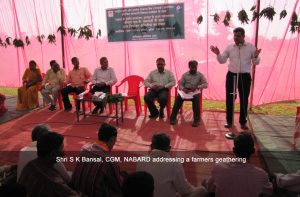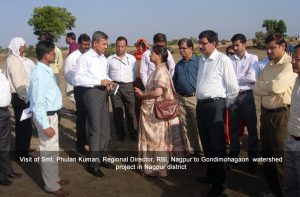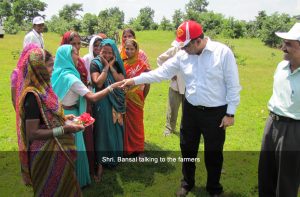Project Monitoring Systems



Project Monitoring Systems
NCT has built a strong internal monitoring system for projects / programmes being implemented by it. Strong parameters have been fixed for each activity carried out by NCT under the project.
I. TDF Projects:
NCT is implementing 16 Tribal Development Projects for NABARD in Maharashtra (7), Madhya Pradesh (5) and Chhattisgarh (4). NCT has developed a system for review and monitoring of these projects.
(a) Projects have been divided into clusters of around 1000 Wadis each.
(b) The work in each cluster is implemented and monitored by a set of supervisors, a technical officer and a cluster (project) in-charge, per cluster.
(c) Each Supervisor has been entrusted with monitoring of around 200 Wadis established in 2-3 villages. These supervisors are responsible for providing necessary guidance to the Wadi farmers. They attend the meeting of farmers’ Village Planning Committees (VPC), they also ensure timely use of Farm Yard Manure, weeding, application of various organic sprays provided, use of organic fertilizers etc. The technical person and project in-charge provides all the required guidance and support to the supervisors.
(d) Every month 20 Wadis of one area in the cluster are monitored a supervisor from another area within the cluster of the same cluster, along with VPC members of that particular village. The senior staff from HO selects 20 Wadis each for 5 supervisors on a random basis and mail the list to project office by 5th of every month. NCT has developed a 100 marks 9 parameter questionnaire for monitoring purposes. The team of supervisor (from another village) and the VPC members visit the wadis randomly selected by NCT’s HO and does the monitoring and grades the work done under the 9 parameters. The farmer whose Wadi has been visited, the VPC members and the supervisor sign the monitoring form as soon as the monitoring work is finished.
(e) 100 monitoring forms (20 each from 5 supervisors) are submitted to the project in-charge by 20th of every month. The project in-charge cross verifies 5 wadis of each farmer adopting the same procedure of providing marks under each of the 9 parameters. In this manner he cross-verifies 25 Wadis monitored by 5 supervisors. The project in-charge also visits another 25 wadis selected randomly and conducts monitoring on the same basis.
(f) By 25th of every month the Project in-charge submits 150 forms (15% of total number of Wadis) of duly monitored wadis to the HO. The senior staff at HO analyze all the forms and a report is prepared on the basis of monitoring findings. The Secretary sends an observation / improvement note to each project in-charge by 30th of every month.
(g) The marks obtained by each wadi is maintained on an excel sheet at HO level. This has helped NCT to keep a track of overall quality and condition of Wadis. The weaker wadis are attended to at the right time and concerned farmers are supported to improve the situation.
(h) The HO team and the Secretary Visit wadi projects once in 2 months. The monitoring data submitted by the field team is again cross-verified to ensure the quality of Wadies established by NCT.
This procedure has helped NCT to maintain high-quality performanance in very Wadi project / Programme implementation.
II. SHG-Bank Linkage Programme:
NCT has promoted over 10000 SHGs since 2002, mainly for NABARD under its SHG-bank credit linkage programme. NCT is working as a Self-Help Group Promoting Institution (SHPI) for NABARD since 2002. Presently NCT is implementing a 5000 SHG bank credit linkage programme is being implemented by NCT in Chhindwara and Seoni districts of Madhya Pradesh State. This huge project is effectively monitored as under;
(a) NCT has a team of around 80 field staff headed by a project coordinator for implementing this programme. At the bottom, the village level there are SHG Preraks. They form and nurture around 70-80 SHGs. For every 10 Preraks there is one Field supervisor and at the block level there is Block Coordinator and at the project level there is a Project coordinator. Also, there is an accountant and 4 SHG trainers are working under this project.
(b) Every month, every Prerak attends monthly meetings of 40-45 SHGs and fills a format and gets it sealed/signed by the SHG Presiden & secretary. He collects details such as monthly savings, internal lending and repayment, bank loan repayment etc during the meeting. He also collects the details of specific resolutions passed by an SHG.
(c ) Field Supervisor or FO attends 60 SHG meetings in a month. 40 meetings are attended along with the Preraks and 20 meetings independently. He also collects same information as Preraks from the SHGs during SHG meetings.
(d) Block Coordinators also attend 60 SHG meetings a month 40 with Preraks and 20 independently. He also collects similar information from SHGs.
(e) The Accountant and the Project Co-ordinator attends 20 SHG meetings along with field staff or/and independently.
(f) All these meetings have to be rescheduled between 5th to 25th of every month. By every 28th of the month all the block wise completed formats are to be submitted to project office.
(g) The information so collected is then submitted to the HO and HO team visits the field on a regular basis for monitoring and cross-verifying the data submitted by the field team.
(h) The field team submits photographs of SHG meetings on a regular basis on WhatsApp group account.
